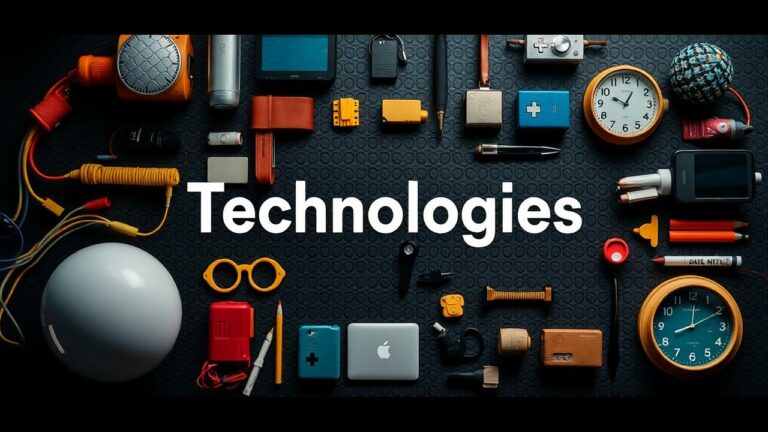Industry-leading tech solutions
Integration of AI and Machine Learning
The fusion of artificial intelligence and machine learning into the fabric of technological frameworks is nothing short of a seismic shift for numerous industries. Organizations are harnessing these cutting-edge technologies, not merely to boost operational efficiency but to completely overhaul their processes in ways that were once unimaginable. By sifting through mountains of data, AI-driven systems unveil intricate patterns and deliver insights that empower decision-makers, ultimately steering businesses toward improved outcomes.
As companies dive deeper into the realms of AI and machine learning, they uncover distinct advantages that sharpen their competitive edge within the marketplace. With intelligent solutions at their fingertips, organizations can automate mundane tasks—liberating human talent to focus on high-stakes strategic endeavors. But that’s just scratching the surface; these technologies also hold the power to elevate customer experiences through tailored interactions, nurturing deeper connections and cultivating unwavering customer loyalty. The monumental potential embedded in AI and machine learning spans across sectors like wildfire, igniting a wave of investment in these groundbreaking innovations as businesses scramble to keep pace with this relentless evolution.
How Intelligent Solutions Drive Competitive Advantage
Intelligent solutions—oh, what a marvel! They ride the waves of data analytics and automation, crafting an intricate tapestry that optimizes operations while elevating decision-making across a myriad of sectors. Imagine this: by weaving artificial intelligence into the very fabric of existing systems, businesses can unearth inefficiencies lurking in the shadows, foresee market trends on the horizon, and nimbly adjust their strategies like seasoned dancers on a stage.
But wait! There’s more to this tale. These advantages don’t just tidy up workflows; they open floodgates to substantial cost savings that ripple through organizations. Companies embracing such innovative paths position themselves as agile warriors ready to tackle the ever-shifting tides of consumer demand while solidifying their stronghold in fiercely competitive arenas.
And let’s not overlook machine learning—the pièce de résistance! This powerful tool enables organizations to sculpt their services and products with meticulous precision tailored to individual customer desires. Such personalization isn’t merely nice; it cultivates profound connections and unwavering loyalty among customers, translating effortlessly into golden revenue opportunities. As intelligent solutions evolve—spiraling forward at breakneck speed—they’ll undoubtedly carve out even sharper edges for competitive advantage. Businesses won’t just keep stride with industry currents; they will boldly set new standards for triumph along the way!
| Intelligent Solution | Key Benefit | Impact on Businesses |
|---|---|---|
| Data Analytics | Identifies inefficiencies | Optimizes operations and enhances decision-making |
| Automation | Streamlines workflows | Reduces operational costs and increases efficiency |
| Artificial Intelligence | Forecasts market trends | Enables agile response to consumer demand |
| Machine Learning | Personalizes customer experiences | Builds customer loyalty and drives revenue growth |
| Predictive Analytics | Anticipates customer behavior | Improves marketing strategies and product development |
The Impact of Cloud Computing on Tech Solutions
Ah, cloud computing—what a game-changer! It’s not just shifted; it’s practically revolutionized the entire realm of tech solutions, bestowing upon businesses an unmatched level of flexibility and scalability that was once merely a dream. Imagine this: organizations now have the ability to access and store mountains of data from afar, slashing the reliance on cumbersome on-premises infrastructure. This seismic shift? It means applications and services can be deployed at lightning speed, allowing companies to pivot in response to market demands with breathtaking agility.
But wait—there’s more! The beauty of cloud solutions lies in their power to supercharge collaboration among teams. Picture it: centralized access to resources and information transforms how employees engage with their work—from virtually anywhere on the globe. We’re talking about fostering a remote work environment that’s not just functional but remarkably efficient! And let’s not forget about integration—it’s like magic how easily these tools mesh with other software platforms, streamlining operations while empowering innovation.
As organizations dive deeper into this ocean of cloud-based services, the ripple effects on productivity and operational efficiency are nothing short of strikingly evident. In fact, you can almost see the impact unfurling before your eyes as they harness these technologies for competitive advantage in their industries. So buckle up—the future is here!
Advantages of Cloud-Based Services for Businesses
Cloud-based services present a tantalizing array of cost-saving opportunities for businesses, slashing the dependence on cumbersome physical infrastructure and relentless maintenance. Imagine companies deftly scaling their resources in tune with demand—it’s like conducting a symphony of operational expenses! This remarkable flexibility empowers organizations to wield their budgets with strategic finesse, channeling funds into innovative pursuits rather than getting bogged down by upkeep or hefty upfront costs.
But wait, there’s more! These services also unleash an exhilarating wave of accessibility and collaboration. Teams can tap into critical applications and vital data from virtually anywhere—yes, even while sipping coffee at that quaint café around the corner! This not only champions remote work but supercharges productivity too. The magic happens when information flows seamlessly in real time; it’s a collaborative dance that elevates efficiency and accelerates decision-making processes. In this dynamic landscape, businesses are primed to pivot swiftly in response to market shifts and the ever-changing demands of customers. Isn’t it fascinating?
Cybersecurity Measures in Advanced Tech Solutions
As businesses dive headfirst into the whirlwind of advanced technology solutions, the stakes skyrocket for robust cybersecurity measures. The lurking shadows of cybercriminals loom larger than ever, hungry to exploit any crack in the armor of systems and networks. Layered security protocols—oh, how essential they become! They stand as sentinels guarding sensitive data while fiercely protecting customer trust. We’re talking encryption galore, relentless security audits on a regular cadence, and those sharp-eyed intrusion detection systems that catch suspicious activity before it spirals out of control.
But wait—there’s more! Employee training isn’t just an afterthought; it’s a linchpin in creating a culture steeped in security awareness. It’s all about reducing those pesky human errors that can unwittingly pave the way for breaches.
Moreover, regulatory compliance has taken a dramatic turn: now it places cybersecurity front and center in business strategy discussions! Companies are scrambling to meet various standards like GDPR or CCPA—these aren’t mere suggestions; they mandate stringent data protection measures. Slip up here? Not only could you face financial penalties that sting but your company’s reputation takes a nosedive too.
So what’s the takeaway? By weaving strong cybersecurity practices into their technological fabric, businesses not only fend off risks associated with data breaches but also ensure smooth sailing through an increasingly digital landscape where threats lurk at every corner.
Protecting Data and Ensuring Business Continuity
In today’s dizzying digital realm, the significance of cybersecurity measures is nothing short of monumental. Organizations grapple with an array of menacing threats—data breaches lurking in the shadows, ransomware attacks ready to pounce at any moment. The implementation of robust security protocols isn’t just advisable; it’s absolutely vital for shielding sensitive information from prying eyes. Think encryption, firewalls, and multi-factor authentication—these aren’t mere tools; they’re formidable barriers standing guard against unauthorized incursions. These technologies do more than protect data; they bolster an organization’s resilience, ensuring that operations can continue to hum along even when chaos strikes.
But let’s not kid ourselves: safeguarding business continuity demands a strategy that’s far more intricate than simply locking down data. Organizations must craft incident response plans and engage in regular risk assessments to unearth vulnerabilities before they become catastrophic failures. Equally crucial is training employees to spot potential threats—a task made all the more pressing since human error often emerges as the Achilles’ heel in cybersecurity defenses. By cultivating a culture rich in awareness and preparedness, companies can slash risks significantly while enhancing their agility in bouncing back from disruptions. This proactive stance doesn’t merely secure valuable assets; it weaves a tapestry of trust with clients and stakeholders alike—a foundation critical for long-term success!
Future Trends in Technology Solutions
The landscape of technology solutions is in a whirlwind of transformation, with a slew of emerging trends set to redefine the industry’s future. At the forefront, we find artificial intelligence and machine learning weaving their way into an ever-expanding tapestry of applications. These powerful tools empower organizations to elevate operational efficiency, automate intricate processes, and unearth priceless insights buried within vast data troves. Those businesses that harness these innovations are poised to carve out a competitive advantage—making smarter decisions at lightning speed and adapting nimbly to the unpredictable shifts in market dynamics.
Meanwhile, another pivotal trend is gaining momentum: edge computing. This game-changing approach slashes latency by processing data right where it originates—not miles away in some distant cloud hub. Such proximity accelerates data analysis and enhances response times for mission-critical applications. With the Internet of Things (IoT) sprawling across industries like ivy on brick walls, the thirst for robust edge computing solutions will surge—enabling real-time data crunching and optimizing resource allocation like never before. Companies that embrace this technological evolution won’t just ramp up productivity; they’ll also revolutionize customer experiences through interactions that are not only timely but strikingly relevant as well!
Emerging Technologies to Watch
The technological landscape is an ever-shifting tapestry, woven with threads of innovation that seem to sprout overnight, each one promising to upend the status quo in remarkable ways. At the cutting edge lies quantum computing, a veritable powerhouse of processing capability that holds the potential to transform realms like cryptography and intricate simulations beyond recognition. Then there’s biotechnology—oh, how it dazzles! It’s not just merging with healthcare; it’s crafting bespoke treatment pathways through astute data analytics and the wizardry of AI.
But wait! The Internet of Things (IoT) is bursting onto the scene like confetti at a parade, knitting together an increasing array of devices into a cohesive web where communication flows seamlessly. This surge isn’t merely about connectivity; it heralds smarter living spaces and turbocharged efficiency across diverse sectors. And let’s not overlook augmented reality (AR) and virtual reality (VR), technologies gaining momentum faster than you can say “immersive experience.” In education and training especially, these innovations are reshaping learning landscapes while unlocking fresh avenues for engagement in both consumer realms and business arenas alike.
Partnering with Leading Tech Providers
Teaming up with top-tier technology providers can dramatically elevate a business’s operational prowess. Such alliances open the door to avant-garde resources and specialized know-how that might be elusive within the confines of one’s own organization. This dynamic collaboration not only supercharges innovation but also streamlines workflows, empowering companies to react nimbly to shifting market demands. By tapping into the strengths of established tech giants, firms can deploy powerful solutions that tackle present-day hurdles while keeping an eye on future necessities.
Forging strategic bonds with tech vendors cultivates an atmosphere ripe for continuous enhancement and collective wisdom sharing. It paves the way for integrating best practices, allowing organizations to maintain their competitive edge in a landscape that’s constantly morphing. Moreover, these partnerships frequently yield bespoke solutions finely tuned to meet distinct operational needs, ensuring businesses get the most bang for their buck. The synergy birthed from these collaborations can translate into heightened performance and superior overall results—a win-win scenario!
Building Strategic Relationships for Success
Forging robust partnerships with top-tier tech providers can dramatically elevate a business’s capacity for innovation and efficiency. Teaming up with industry stalwarts opens the door to specialized expertise, cutting-edge resources, and invaluable insights into ever-changing market dynamics. These alliances cultivate a vibrant culture of shared knowledge and collaborative problem-solving—an absolute necessity when maneuvering through the intricate maze of technological advancements.
Dedicating time and energy to nurture these relationships often reaps impressive rewards in terms of competitiveness and scalability. Strategic alliances grant businesses prime access to emerging technologies and breakthroughs, facilitating quicker implementation and adaptation. In the end, such partnerships empower organizations to stay nimble, allowing them to deftly respond to shifting customer needs and industry transformations.
- Establish clear goals and expectations from the outset to ensure alignment.
- Engage in regular communication to foster trust and transparency among partners.
- Leverage each partner’s strengths to maximize collective advantages.
- Invest in joint training and development to enhance capabilities and knowledge sharing.
- Monitor and evaluate the partnership’s performance to identify areas for improvement.
- Celebrate successes together to strengthen bonds and encourage ongoing collaboration.
- Stay open to feedback and be willing to adapt strategies as needed for mutual benefit.
Conclusion
The relentless march of technology is reshaping the very fabric of industrial solutions at a dizzying pace. Organizations daring enough to embrace the latest breakthroughs in artificial intelligence, cloud computing, and cybersecurity find themselves poised on the brink of remarkable growth and unparalleled resilience. By weaving these advanced technologies into their operations, businesses are not just streamlining processes; they’re crafting seamless customer experiences and boosting overall efficiency like never before.
But wait—let’s not overlook the critical role of partnering with top-tier technology providers. The power of strategic alliances cannot be brushed aside! Such collaborations spark an electrifying environment brimming with innovation and shared wisdom. This synergy doesn’t merely sharpen competitive edges; it fortifies businesses against the whirlwind changes characteristic of today’s market landscape. To prioritize cutting-edge tech solutions isn’t just smart—it’s a blueprint for future triumphs waiting to unfold!







